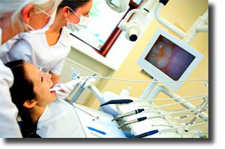Underbite Surgery

If Underbite Surgery Is Necessary
Whether or not underbite surgery will be required depends of course on the severity of the problem, and also depends on the age of the individual involved. An underbite is not a tooth problem, even though the upper and lower teeth are not aligned as they should be. An underbite is a skeletal situation, affecting the jawbones. Put more accurately, an underbite, often considered genetic, is regarded as a skeletal situation once a person approaches adulthood and the skeletal bones, in this case the facial and jawbones, have settled into their permanent positions. For an infant or a very young person, there are often other options rather than surgery available to correct the condition.
When one has an underbite, the lower teeth will be positioned in front of the upper teeth. This is most noticeable with the front teeth, which may not make contact when the jaw is closed. The position of the edges of the upper and lower teeth may differ only a tiny fraction of an inch in many if not most cases, and a person's ability to bite and chew food may not be significantly affected, nor may the condition be noticeable from a cosmetic perspective. In extreme cases however, the difference in relative position of the upper and lower teeth may be pronounced, making biting a chewing of food very difficult, and significantly affecting a person's facial appearance.
No Quick Fix - There are no quick and easy solutions to an underbite condition. Even surgery involves lengthy preparation and healing times. Treatment of an underbite is generally easiest when very young patients are involved, as the jaw positions can often be corrected through a continual application of pressure. A child may have an underbite that does not seem to pose a problem. However there are a number of things, from the use of pacifiers, to thumb sucking, to eating habits, which can make the underbite worse since the facial bones are still somewhat malleable at an early age. If an underbite condition is observed, care should be taken that nothing is allowed to happen that will make it worse. Even if treatment isn't necessary initially, the situation could arise where underbite surgery might be required at some point during the person's adult years.
The Surgery Itself - Underbite surgery unfortunately involves a bit more than a visit to an oral surgeon, or orthodontist. It may be determined that braces will be required for a year and perhaps even more, before surgery is even attempted. Once the surgery has been completed, braces may be required again for an additional 6 months to a year. The reason for the braces is to align the teeth as much as possible before the jawbone itself is dealt with. If the condition is the result of a jawbone that is undersized, surgery could be quite extensive, and there always exists the possibility that both upper and lower jawbones may have to be operated upon. The jawbone is usually cut to allow a portion of it to slide into the desired position, after which it is secured with plates and/or screws. The surgery is almost always done from the inside of the mouth to eliminate chances of facial scarring.
A Painful Recovery - The underbite surgery recovery process will usually be painful and pain medication will be needed initially. Besides the pain, the area of the jaw may experience significant swelling for a few days, and the gums will be sore and tender for several weeks. In extreme cases it may even be necessary to wire the jaw shut during the healing process. As one can see, underbite surgery is not fun, although the final results will more often than not make it all worth it.
Underbite surgery is expensive as well. Exact prices cannot be quoted as the severity of the condition and the surgical procedure can vary significantly from case to case. A great deal of expense and pain can often be avoided if the problem is nipped in the bud, and at an early age.